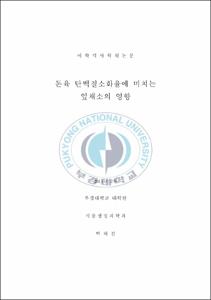돈육 단백질소화율에 미치는 잎채소의 영향
- Alternative Title
- Effect of Leafy Vegetables on the Pork Protein Digestibility
- Abstract
- To know the effect of leafy vegetables on the protein quality of pork meat, changes in trypsin indigestible substrates(TIS) and computed protein efficiency ratio(C-PER) were studied as regards the eating style(meat and vegetables taken at the same time, eating vegetables after and/or before pork meat). The freezed dried leafy vegetables used in this experiment was Korea romaine lettuce, perilla leaf and Korean cabbage.
The total dietary fiber(TDF) content was in the range from 32.32%(Korean cabbage) to 27.39%(Korean romaine lettuce), acid detergent fiber(ADF) was in the range from 13.26%(Korean romaine lettuce) to 11.57%(Korean cabbage), neutral detergent fiber(NDF) was in the range from 20.67%(perilla leaf) to 13.29%(Korean cabbage) and soluble dietary fiber(SDF) was in the range from 9.1%(Korean cabbage) to 7.13%(Korea romaine lettuce) in 100g of solid.
The in vitro digestibility of pork protein was lowered with increasing fiber addition. For casein digestibility in the presence of fiber constituents, pectin(1.68%∼7.36%) was more effective in lowering digestibility than cellulose(0.13%∼6.47%).
From 0.83%(boiled pork-Korean romaine lettuce simultaneously intake) to 7.5%(taking Korean cabbage before boiled pork) of digestibility was decreased when the freeze dried boiled pork and leafy vegetables powder were reacted at 37℃ for two hours. If boiled pork and leafy vegetables were taken at the same time, the decreased in digestibility was ranked in the following order : Korean cabbage(2.72%∼6.05%)>perilla leaf(1.93%∼3.34%)>Korean romaine lettuce(0.83%∼7.63%). And boiled pork were taken before vegetables, the decreased in digestibility was decreased as follows : Korean cabbage(3.24%∼4.82%)>pellia leaf(3.2%∼4.86%)>Korean romaine lettuce(2.9%∼5.66%).
When leafy vegetables were taken prior to boiled pork , the digestibility was decreased as follows : Korean cabbage(6.32%∼7.5%)>Korean romaine lettuce(5.77%∼6.45%)>pellia leaf(5.74%∼6.33%).
From 42.48 mg/g(Korean romaine lettuce) to 71.81%(Korean romaine lettuce and perilla leaf) of TIS(trypsin indigestible substrate) was formed as added dietary fiber source vegetables reacted with boiled pork protein.
Free amino acids contents expressed as DL-leucine equivalents was decreased as increasing quantities of leafy vegetables. From 18.10mg/100g(boiled pork-perilla leaf taken simultaneously) to 12.36mg/100g(boiled pork-Korean romaine lettuce taken simultaneously) of free amino acid were released after reacting pork meat with dietary fiber source vegetables.
Computed protein efficiency ratio(C-PER) was also decreased as increasing quantities of leafy vegetables. From 3.18(boiled pork-Korean romaine lettuce taken simultaneously) to 3.04(taking Korean cabbage before boiled pork) of C-PER was calculated whereas boiled pork meat showed C-PER of 3.20.
From the results above, the decrease in vitro protein digestibility was ranked in the following order: eating meat after vegetables intake>eating meat before vegetables intake>meat and vegetables taking simultaneously. This means that the in vitro pork protein digestibility depends on eating styles. When boiled pork-vegetables taking at the same time, Korean cabbage was the found to have the most effect on digestibility of pork meat and perilla leaf have the least effect on digestibility of pork meat. This was evidenced by TIS and total free amino acid contents recored.
- Issued Date
- 2011
- Awarded Date
- 2011. 2
- Type
- Dissertation
- Publisher
- 부경대학교 대학원
- Alternative Author(s)
- Park, Hye Jin
- Affiliation
- 부경대학교 대학원
- Department
- 대학원 식품생명과학과
- Advisor
- 류홍수
- Table Of Contents
- Ⅰ. 서론 1
Ⅱ. 재료 및 방법 4
1. 실험재료 및 시료의 제조 4
1.1. 실험재료 4
1.2. 조리방법 5
1.3. Casein과 cellulose 및 pectin의 반응조건 5
1.4. 보쌈육 및 채소 반응조건 6
2. 일반성분 및 식이섬유소의 분석 7
2.1. 일반성분 7
2.2. 식이섬유소 함량분석 8
3. 단백질 품질평가 11
3.1. 단백질 소화율(in vitro) 11
3.2. Trypsin 비소화성물질(Trypsin Indigestible Substrates, TIS) 정량 12
3.3. 유리아미노산 정량 12
3.4. 단백질 효율비(Computed Protein Efficiency Ratio, C-PER) 13
Ⅲ. 결과 및 고찰 15
1. 일반성분 및 식이섬유소 함량 15
1.1 일반성분 15
1.2. 식이섬유소 함량 17
2. 식이섬유소와 채소 첨가에 따른 단백질 소화율의 변화 23
2.1. Casein과 정제 식이섬유소의 상호반응 23
2.2. 보쌈육과 잎상치의 상호반응 26
2.3. 보쌈육과 들깻잎의 상호반응 28
2.4. 보쌈육과 쌈배추의 상호반응 30
3. Trypsin 비소화성 물질(TIS)의 생성 32
4. 상호반응에 따른 유리아미노산 총량의 변화 33
5. 단백질 효율비(C-PER) 36
Ⅳ. 요약 및 결론 38
Ⅴ. 참고문헌 41
감사의 글 46
- Degree
- Master
- Files in This Item:
-
-
Download
 돈육 단백질소화율에 미치는 잎채소의 영향.pdf
기타 데이터 / 651.85 kB / Adobe PDF
돈육 단백질소화율에 미치는 잎채소의 영향.pdf
기타 데이터 / 651.85 kB / Adobe PDF
-
Items in Repository are protected by copyright, with all rights reserved, unless otherwise indicated.